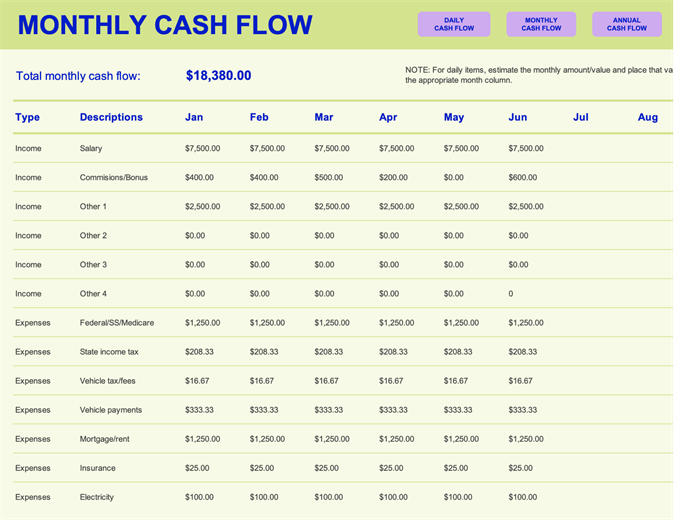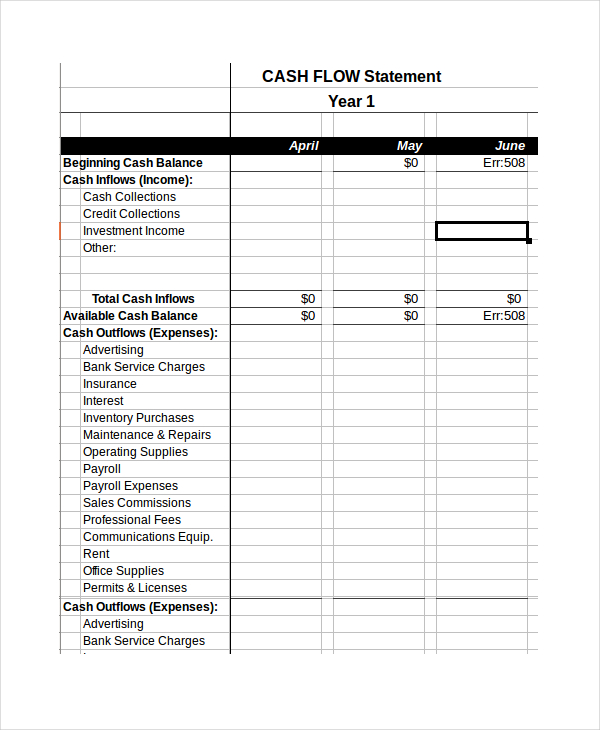Cash Flow Chart Template Excel
Keeping a record of cash flow is a very important job. It is important in order to make a proper budget. Another use of keeping a record of cash flow is to determine various taxes that have to be paid. It is extremely important that the cash flow is in a very systematic fashion. Cash flow templates and Excel templates can come.
Applies To: Excel 2016 Excel 2013 Excel 2010 Excel 2007 Excel Online Have you been losing sleep figuring out the best way to maximize profitability and minimize risk on your business investments? Stop tossing and turning. Relax and go with the flow. Cash, that is. Take a look at your cash flow, or what goes into and what goes out of your business.
Positive cash flow is the measure of cash coming in (sales, earned interest, stock issues, and so on), whereas negative cash flow is the measure of cash going out (purchases, wages, taxes, and so on). Net cash flow is the difference between your positive cash flow and your negative cash flow, and answers that most fundamental of business questions: How much money is left in the till? To grow your business, you need to make key decisions about where to invest your money over the long term.
Simple Cash Flow Template Excel
Microsoft Excel can help you compare options and make the right choices, so that you can rest easy both day and night. Asking questions about capital investment projects If you want to take your money out of the till, make it working capital, and invest it in the projects that make up your business, you need to ask some questions about those projects:. Is a new long-term project going to be profitable?. Is the money better invested in another project?. Should I invest even more in an ongoing project, or is it time to cut my losses? Now take a closer look at each of those projects, and ask:.
What are the negative and positive cash flows for this project?. What impact will a large initial investment have, and how much is too much? In the end, what you really need are bottom-line numbers that you can use to compare project choices. But to get there, you must incorporate the time value of money into your analysis. My papa once told me, 'Son, it's better to get your money as soon as possible and hold on to it as long as possible.'
Later in life, I learned why. You can invest this money at a compounded interest rate, which means that your money can make you more money — and then some. In other words, when cash goes out or comes in is just as important as how much cash goes out or comes in. Answering questions by using NPV and IRR There are two financial methods that you can use to help you answer all of these questions: net present value (NPV) and internal rate of return (IRR). Both NPV and IRR are referred to as discounted cash flow methods because they factor the time value of money into your capital investment project evaluation. Both NPV and IRR are based on a series of future payments (negative cash flow), income (positive cash flow), losses (negative cash flow), or 'no-gainers' (zero cash flow).
NPV NPV returns the net value of the cash flows — represented in today's dollars. Because of the time value of money, receiving a dollar today is worth more than receiving a dollar tomorrow. NPV calculates that present value for each of the series of cash flows and adds them together to get the net present value. The formula for NPV is: Where n is the number of cash flows, and i is the interest or discount rate. IRR IRR is based on NPV.
You can think of it as a special case of NPV, where the rate of return that is calculated is the interest rate corresponding to a 0 (zero) net present value. NPV(IRR(values),values) = 0 When all negative cash flows occur earlier in the sequence than all positive cash flows, or when a project's sequence of cash flows contains only one negative cash flow, IRR returns a unique value. Most capital investment projects begin with a large negative cash flow (the up-front investment) followed by a sequence of positive cash flows, and, therefore, have a unique IRR. However, sometimes there can be more than one acceptable IRR, or sometimes none at all. Comparing projects NPV determines whether a project earns more or less than a desired rate of return (also called the hurdle rate) and is good at finding out whether a project is going to be profitable. IRR goes one step further than NPV to determine a specific rate of return for a project.
Both NPV and IRR give you numbers that you can use to compare competing projects and make the best choice for your business. Choosing the appropriate Excel function hich Office Excel functions can you use to calculate NPV and IRR? There are five:, and. Which one you choose depends on the financial method that you prefer, whether cash flows occur at regular intervals, and whether the cash flows are periodic. Note: Cash flows are specified as negative, positive, or zero values.
When you use these functions, pay particular attention to how you handle immediate cash flows that occur at the beginning of the first period and all of the other cash flows that occur at the ends of periods. Function syntax Use when you want to Comments (rate, value1, value2, ) Determine the net present value using cash flows that occur at regular intervals, such as monthly or annually. Each cash flow, specified as a value, occurs at the end of a period. If there is an additional cash flow at the start of the first period, it should be added to the value returned by the NPV function. See Example 2 in the Help topic. (rate, values, dates) Determine the net present value using cash flows that occur at irregular intervals.

Each cash flow, specified as a value, occurs at a scheduled payment date. (values, guess) Determine the internal rate of return using cash flows that occur at regular intervals, such as monthly or annually. Each cash flow, specified as a value, occurs at the end of a period. IRR is calculated through an iterative search procedure that starts with an estimate for IRR — specified as a guess — and then repeatedly varies that value until a correct IRR is reached. Specifying a guess argument is optional; Excel uses 10% as the default value. If there is more than one acceptable answer, the IRR function only returns the first one it finds. If the IRR doesn't find any answer, it returns a #NUM!
Use a different value for the guess if you get an error or if the result is not what you expected. Note A different guess might return a different result if there is more than one possible internal rate of return.
(values, dates, guess) Determine the internal rate of return using cash flows that occur at irregular intervals. Each cash flow, specified as a value, occurs at a scheduled payment date. XIRR is calculated through an iterative search procedure that starts with an estimate for IRR — specified as a guess — and then repeatedly varies that value until a correct XIRR is reached. Specifying a guess argument is optional; Excel uses 10% as the default value. If there is more than one acceptable answer, the XIRR function only returns the first one it finds.
If the XIRR doesn't find any answer, it returns a #NUM! Use a different value for the guess if you get an error or if the result is not what you expected.
Note A different guess might return a different result if there is more than one possible internal rate of return. (values, financerate, reinvestrate) Determine the modified internal rate of return using cash flows that occur at regular intervals, such as monthly or annually, and consider both the cost of investment and the interest that is received on the reinvestment of cash. Each cash flow, specified as a value, occurs at the end of a period, except the first cash flow, which specifies a value at the beginning of the period. The interest rate that you pay on the money that is used in the cash flows is specified in financerate. The interest rate that you receive on the cash flows as you reinvest them is specified in reinvestrate. More information To learn more about using NPV and IRR, see Chapter 8, 'Evaluating Investments with Net Present Value Criteria,' and Chapter 9, 'Internal Rate of Return,' in by Wayne L. To learn more about this book.
File Format. Xls. Xlsx Size: 39.4KB How to Use a Cash Flow Excel Template? Cash flow templates are very similar to balance sheets and using them is extremely easy. To use the to calculate your net cash flow, you have to make a record of two things, all the assets and liabilities of your organization. Assets include all the sources from which you are to gain, like investments, collections, sales, etc.
These calculate the total amount of money your organization will receive. Then you have to make a note of liabilities, all sources where you will have to spend money. This includes salaries of employees, loan payments, advertising, etc. After entering these values, the template automatically gives you the balance and percentage increase.
Who Can Use the Cash Flow Excel Templates? Cash flow Excel templates can be used by all types of businesses. Small businesses ranging from shops and restaurants to large scale industries can make use of these templates to keep a record of their financial status and also project the status of coming quarters. Accountants are the ones who will benefit the most from the use of these templates as they are the ones who have to keep a record of cash flow and do these complex calculations and make projections regarding the company’s finances. Individuals can also make use of these templates to take care of their own finances.


What are the Benefits of Using the Cash Flow Templates? Cash flow templates have a huge number of benefits. The biggest benefit is that cash flow templates help you in doing complex calculations with ease by making use of the inbuilt functions in Excel. These also decrease any chances of mistake you might commit while making these calculations as you can easily double check your entries, which will be difficult to accomplish if you choose to do these calculations manually. Cash flow templates also help you in listing your finances in a very orderly manner, which can be extremely useful for future references. You save a huge amount of time by using these templates.
If you are looking to make a budget then you can make use of Excel budget templates. Cash flow templates can find use in all kinds of businesses.
Check out all the templates that we have listed above. You are sure to find a template that will help you with your needs.